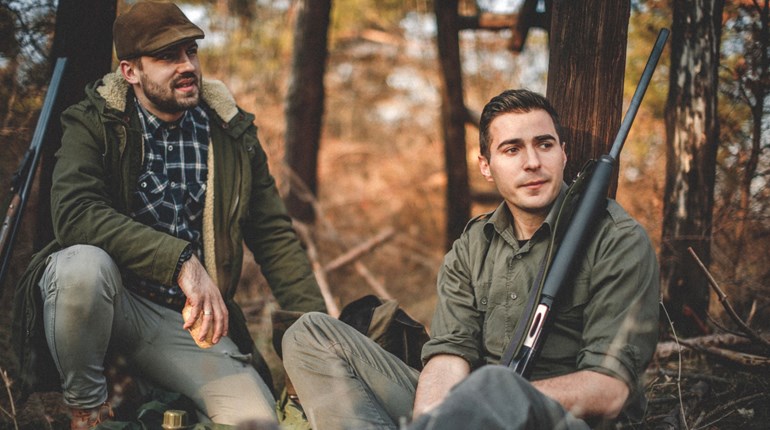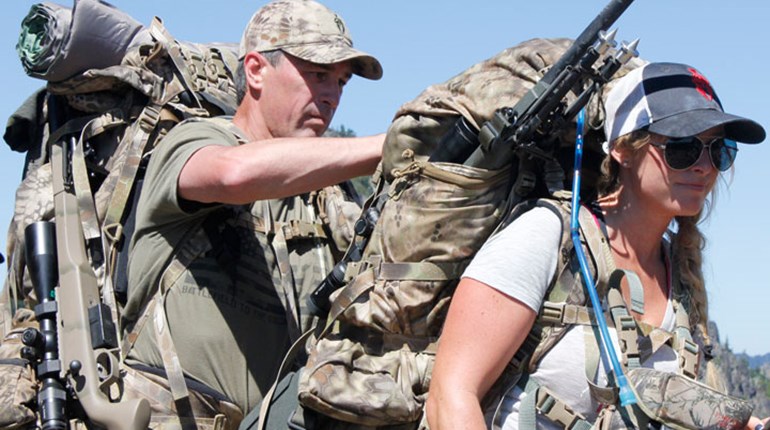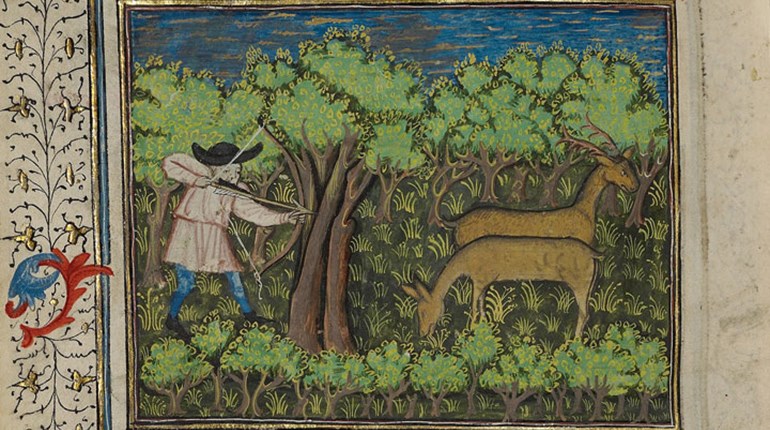There were no cameras to record the grisly scene: clothing torn and bloody; a body ripped open and half-eaten. The elk hunter had died under a heavy dose of adrenaline, but not enough adrenaline to save him. His rifle lay beside the elk carcass he was butchering. He’d been overpowered and savaged by long, sharp fangs and claws wielded by an angry, aggressive beast, one that has been angry and aggressive for centuries—a grizzly bear.
Grizzly. Grisly. Two words, same sound, different spellings. They complement one another nicely, defining two essential characteristics of North America’s orneriest bear. Grisly is a Middle English word meaning frightful, horrible and terrible. Grizzly springs from the old French word gris, meaning gray, the predominant color of the ferocious “new” bear Lewis and Clark “discovered” in 1805, the one that chased them into the Missouri despite absorbing a half-dozen lead balls.
However you spell it, the grizzly is a grisly bear, an apex predator that has long thrilled, challenged and, yes, intimidated American hunters. After 200 years, we’re still not sure how to coexist with this bruin.
•••••
“Whoa bear. Whoa bear!” Our Alaska guide was suddenly tall in the saddle, and after my horse took two more steps toward him, I saw why. A dark, nearly black grizzly was standing on hind legs, glaring at us over the tundra blueberries. Worse, two smaller bears flanked her less than 80 yards away. At charging grizzly velocity, that’s about three seconds in the time-space continuum.
“Stand up! Wave your arms! Heeaaah. Go on bear!”
Mark Kayser, the other hunter in our three-man band, reigned up beside us then, adding needed mass to our group defense. We all shouted. Finally intimidated, mad Mamma griz snorted, turned and fled, chasing her yearling cubs before her.
After they’d crossed a distant ridge, I nodded toward Mark and pointed out something:
“Your rifle’s still in your scabbard.”
“So’s yours.”
“So’s mine,” said our guide, somewhat sheepishly.
That’s the trouble with grizzly encounters. They happen fast. Sometimes too fast. Your life is often in their paws, regardless of the rifle you carry. This is part of the allure, the reason 21st century hunters still take on the grizzly challenge. Can we measure up? Do we have the skills and composure to take one of North America’s most formidable predators? Do we even want to try?
Given today’s rifles, magnum cartridges and scopes, the answer should be an easy “yes.” Nevertheless, every year there are altercations. Every few years there is a mauling or death. Grizzlies may not be the Devil incarnate, but when one is standing over you, biting, raking, tearing, slobbering and roaring, it might as well be.
Since 2010, grizzlies have killed five people in North America, all of the victims adult males. None had been hunting. From 2000 through 2009, grizzlies killed a dozen of us, including three women. Three of the victims had been hunting. The 1990s saw 15 people taken by grizzlies, the 1980s 10. Most were men, probably because more men than women spend time in the wilds. Interestingly, from 1910 through the 1950s only three to five people were victims of grizzlies each decade. The recent increase in deaths could be a result of either more bears now or more humans spending more time in bear country, or a combination of both.
•••••
Maybe today’s grizzlies have shorter fuses.
“About time you guys got back!” The cook at our Brooks Range hunting camp was somewhat put out when we returned late from yet another day of unsuccessful bear searching. “The bears have been all over this place.”
“Seriously? We’ve been scouring the mountains and they’ve been here? In camp?”
“Two of them. Didn’t you hear me? I fired four shots at them no more than an hour ago.” She brandished her stainless Smith & Wesson .357 Magnum. “One was practically inside the tent.”
That was one brave woman. Not many would choose a .357 Magnum handgun as first-line defense against a grizzly, although that undersized cartridge did save a Montana game warden’s life in the late 1980s. The man was relocating a trapped nuisance grizzly near Glacier National Park when the remote trap door release wouldn’t work. The veteran warden climbed atop the culvert trap and lifted the gate manually. To show its appreciation, the bear climbed out, reached up, pulled the door, culvert and warden to the ground, and began chewing him a few more holes. The man was able to draw his service revolver and empty it into the bear. The sixth shot caught it in the brain. The warden limped home to recover from bites and a broken leg.
One doesn’t entertain a grizzly hunt lightly. Done properly, however, it needn’t be any more dangerous than an elk or mule deer hunt—or a Sunday afternoon hike, for that matter—in grizzly country. The keys are to know bears and their habits, know your rifle, ammo and bullet, and know how to wield them effectively, i.e., hit the bear in the right place.
•••••
As for grizzly behavior, it seems to fall into three major categories, and there’s something fishy about the first.
Where grizzlies have access to abundant salmon runs, they grow huge and relatively docile. We call them brown bears. Genetically they are the same as interior grizzlies, the main difference being size, pelt coloration and attitude. Brown bears by and large seem happy to concentrate on fish and leave humans alone. Not always. They’ve mauled and killed their share of us, but compared to interior grizzlies, brownies are downright polite.
“I think I’d be grumpy too if I had to scrounge around for soap berries and ground squirrels while my cousins on the coast were having salmon fillets every night,” Alaska guide Lance Kronberger once told me. It was as good an explanation as any for the rather sharp divide in temperament between the two groups.
The second category of grizzly behavior is the “apex predator syndrome.” Being the biggest, baddest beast on the prairie and tundra, interior grizzlies can afford to be bullies. Who’s going to stop them? Black bears often grow bigger than interior griz, but you don’t find them lollygagging around open grizzly habitat. Wherever trees dwindle to nothing, so do black bears. Without climbing trees, black bears can’t escape rampaging grizzlies that’ll happily eat them. Same goes for cougars. You don’t find them far from trees or cliffs in grizzly country. Wolves freely roam grizzly tundra because they can outrun the bears. A pack of wolves can challenge and sometimes even kill a griz, but it’s going to be a large pack willing to risk a few casualties.
The one beast that can stand up to an interior grizzly? Polar bear. By most accounts the white bear is more than a match for any grizzly. It has the bulk of the coastal brown bear coupled with more predatory instinct than a griz. Polar bears don’t stoop to eating berries. It’s meat or fast for them, and I doubt a thousand-pound white bear would back away from trying to take a 400-pound grizzly to dinner. Fortunately for the smaller bear, it rarely encounters its white cousin. When the two do meet, the grizzly probably has sufficient instinct to keep its distance. On at least one occasion, the two species made love instead of war, as proven by genetic testing of the hybrid “grolar” bear a hunter legally shot in the Canadian Arctic in 2006.
The third possibility for the grizzly’s nasty demeanor might reflect our changing relationship with the species. The theory, unproven, is “learned response.” In places like Yellowstone National Park where grizzlies haven’t been hunted for years, they’ve learned they can throw their weight around without repercussion. If they were hunted, so the theory goes, they’d learn to fear humans. I’m not so sure. Certainly any bears shot would have their aggression radically moderated, but how would that educate the survivors? On the other hand, there is the suggestive evidence that the low number of human deaths by grizzly attack from 1900 through 1960 may have been due to their persecution at the time. In those decades grizzlies were not just hunted, but nearly extirpated from the Lower 48 as unwanted livestock killers. Certainly there were few recreational hikers, bikers and backpackers in the wilds then, but plenty of ranchers, miners and sheep herders. Did their harassment of the bears teach the animals to keep their distance? We may never know.
•••••
What we do know is that both grizzly bear numbers and grizzly bear attacks are up in the northern Rockies, so far up that fish-and-game agencies are proposing limited hunting seasons. Grizzlies have moved from the depths of the mountains to the Front Range foothills and are now following rivers like the Milk, Missouri and Musselshell far east onto the plains. Ranch country. Settled country. Espousing love for grizzlies is one thing when they’re on your TV screen, another when they’re on your porch.
Perhaps you’ll win a tag in any upcoming grizzly seasons in the northern Rocky Mountain states. Maybe you’ll book a hunt in Canada or Alaska. Either way, if you wish to challenge the fiercest man-killer in North America, the grisly grizzly, prepare yourself. You’ve got to respect the power, ferocity, cunning and unpredictable nature of this bear.





































